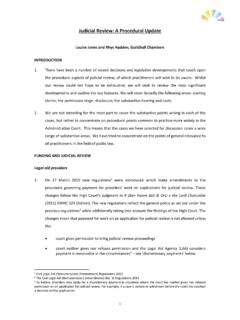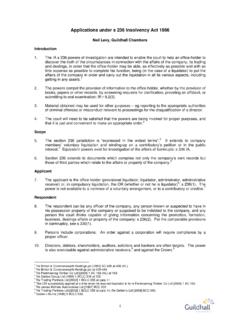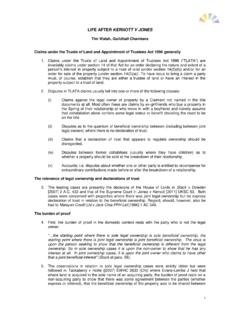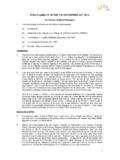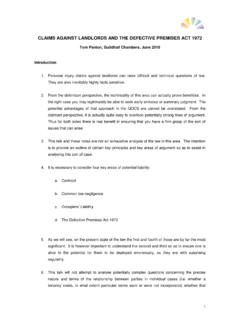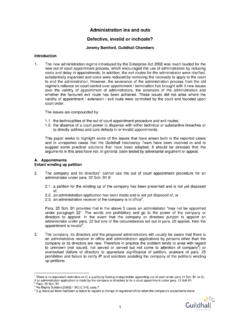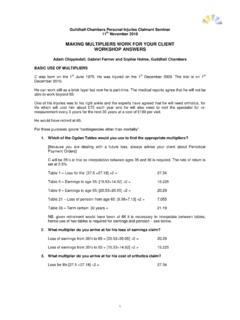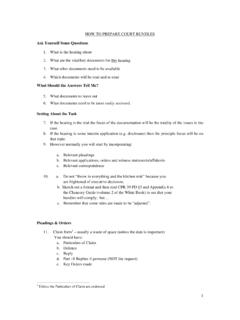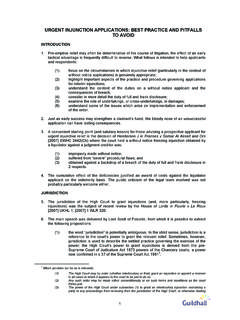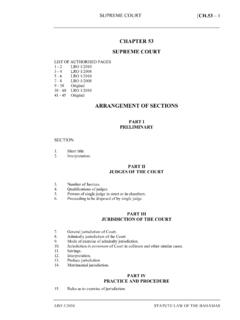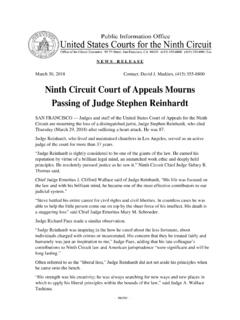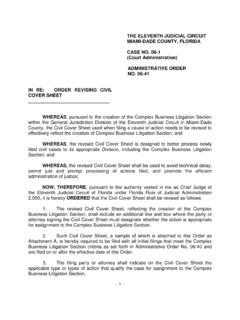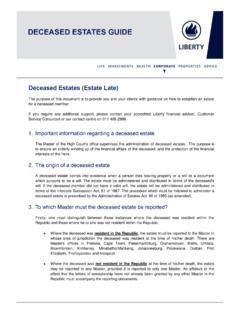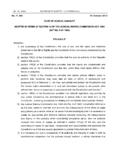Transcription of Shedding light on the law and ... - Guildhall Chambers
1 Shedding light on the law and practice of adjourning / dismissing insolvency petitions Daisy Brown, Guildhall Chambers Everything about insolvency petitions marks them apart from ordinary litigation. The Civil Procedure Rules are largely inapplicable. There are no parties in a strict sense, no statements of case nor disclosure and no oral evidence nor trial. Every hearing is a final hearing unless it is postponed to another final hearing. It is therefore of great importance for the practitioner to know and understand the law and practice of adjourning petitions. Unfortunately, this is not set out in the Act or Rules. Instead, it is largely derived from judge-made law. Even then, it is difficult for the uninitiated to find. The recent decision in Aabar Block v Glenn Maud [2015] EWHC 3681 (Ch) ( Maud ) is a welcome review of the authorities. The simple message is that the discretion to adjourn/postpone is very wide and, whilst there are certain general rules of thumb, its exercise is highly fact-sensitive.
2 The two-stage test Creditors are often well-rehearsed in the principles that the court will apply in response to an application to set aside a statutory demand, assuming the procedural formalities have been observed, whether the debtor appears to have a cross claim or disputes the debt1. However, it is often assumed that once those arguments have been aired in full and leave is given to present a bankruptcy petition (again, assuming due compliance with the procedural and formal requirements as to service and filing), the bankruptcy order will be made. Various authorities have confirmed that, although no issue estoppel arises, arguments run in an earlier set-aside application cannot be re-litigated at the petition hearing absent a significant change of circumstance2. In fact, the court is emboldened at the petition hearing by the more general discretion provided in section 266(3) of the insolvency Act 1986 which provides: The court has a general power, if it appears to it appropriate to do so on the grounds that there has been a contravention of the rules or for any other reason, to dismiss a 1 Rule (4) of the insolvency Rules 1986 2 Turner v Royal Bank of Scotland [2000] 683, Atherton v Ogunlende [2003] 21, Roseoak Investment Ltd v Network Rail [2010] 646 bankruptcy petition or to stay proceedings on such a petition ; and where it stays proceedings on a petition , it may do so on such terms and conditions as it thinks fit.
3 This is supplemented by rule (1) of the insolvency Rules 1986 which provides that the court may make a bankruptcy order if satisfied that the statements in the petition are true and that the debt on which it is founded has not been paid, or secured or compounded for . The general discretion to adjourn or dismiss a petition has deep, pre-1986 Act roots. Notwithstanding the fact that s8 of the Bankruptcy Act 1869 had mandatory language, the court had a discretion to refuse to make a man bankrupt for an improper purpose, and to annul an adjudication when the justice and the convenience of the case require it 3. Examples of where the court would apply its discretion included where it was satisfied that the debtor s sole asset would be destroyed4 and where there would be no value to the creditors if an order were to be made5. Section 5(3) of the 1914 Act, the predecessor to s266(3), provided If the court is not satisfied with the proof of the petitioning creditor's debt, or of the act of bankruptcy, or of the service of the petition , or is satisfied by the debtor that he is able to pay his debts, or that for other sufficient cause no order ought to be made, the court may dismiss the petition .
4 " This discretion was a general one, its exercise being entirely dependent upon the facts of the case6. The same now applies under the current legislation. There is no room for the court on the final hearing of an insolvency petition for the modern approach to ordinary civil trials where, under CPR PD 29 para , postponement of the final hearing is a last resort . 3 Ex parte McCulloch (1880) 14 ChD 716 4 Re Birkin (1869) 3 Man 291 5 Re Betts [1897] 1 50 6 Malcolm Robert Ross (A Bankrupt)( ) [2000] BPIR 636 at [27] However, despite the seemingly wide ambit of the discretion, there have always been certain working rules and, on occasion, settled practices in relation to the adjournment and dismissal of insolvency petitions. Dismissal of petitions General practice has dictated a starting position that where the petitioning creditor has established that he has fulfilled all the statutory conditions, he is prima facie entitled to a bankruptcy order7.
5 This is akin to an evidentiary burden. It will be a very unusual case in which those conditions have been fulfilled and the petition is dismissed. In Shepherd v LSC [2003] 140, a bankruptcy order was made notwithstanding the fact that it was conceded by all sides that there were no assets to realise. In John Lewis v Pearson Burton [2004] it was held that a district judge had been wrong to have dismissed a petition using the discretion vested by s266(3) because the creditor had refused an offer by the debtor to repay within 7 years. Even where there has been a delay of more than 4 months between the service of the statutory demand and the presentation of the petition , the court will not dismiss it unless the debtor has demonstrated that he has suffered prejudice as a result8. Formal defects will not normally justify the dismissal of a petition9. If there is an abuse of process, the petition will be dismissed.
6 As set out in Re Majory [1955] Ch. 600 court proceedings may not be used or threatened for the purpose of obtaining for the purpose of the person so using or threatening them some collateral advantage to himself, and not for the purpose for which such proceedings are properly designed and exist; and a party so using or threatening proceedings will be liable to be held guilty of abusing the process of the court and therefore disqualified from invoking the powers of the court by proceedings he has abused." However, an improper purpose or ulterior motive will not justify a dismissal of the petition where part of the purpose is to obtain the bankruptcy order10. 7 Re A Debtor No. 452 of 1948 [1984] 1 WLR 1143 8 Dunbar Assets plc v Fowler [2013] 46 9 Re A Debtor ( of 1997) [2000] BPIR 302 10 Malcolm Robert Ross (A Bankrupt)( ) [2000] BPIR 636, Re Glenn Maud [2015] 845, Examples of unusual circumstances in which a petition has been dismissed include where there was an issue estoppel relating to the debt (Inland Revenue v Khan [2005] BPIR 409) and where there was an incomplete previous bankruptcy in relation to which it was not clear whether there would be a surplus (Re Ross (A Bankrupt) [2000] BPIR 636).
7 Discretion to adjourn In contrast, the power to adjourn the petition has been much more effectively deployed. In reaching the decision to adjourn the petition , the court is prepared to take into account various factors including the background to the petition and whether an immediate bankruptcy order is in the interests of the creditors as a whole. Petitions will often be adjourned, or instance: (i) to allow technical defects to be addressed; (ii) to enable evidence on either side to be heard fully; (iii) to enable the debtor to satisfy the court of his ability to pay the debt; or (iv) to allow some other act or event to occur which will be for the benefit of the creditors as a whole. In Re A Debtor, ex parte Petitioning Creditor, (1920) 89 LJKB 432, the Divisional Court in bankruptcy dismissed an appeal by a petitioning creditor of a decision of a registrar acceding to a request to a second adjournment (to an overall period of 4 months on the basis of slender evidence that negotiations were on foot for the sale of freehold property (from the proceeds of which all debts could be paid).)
8 The petitioning creditor's appeal against the second adjournment was dismissed. It held that, despite thin evidence of the proposed sale and/or its prospects and other pressing creditors, the registrar had been entitled to take the view that an adjournment would establish whether, at the adjourned hearing, the debtor would be able to pay her debts and thus that the petition should be dismissed. In his short judgment, McCardie J followed the decision of the Court of Appeal in In re Heyl [1918] 1 KB 452 and described the registrar's discretion to adjourn in the widest terms. He went on to identify 3 "important grounds" upon which a registrar may adjourn a bankruptcy petition , the third of which was: "to enable the debtor, in the event of his being able to do so, to satisfy the Registrar of his power to pay his or her debts in full", concluding: "It is on this last ground that adjournments are generally granted, and it is on this last ground that I conceive that this adjournment was granted".
9 In In re De Courcy (A Debtor) (1968) 112 Sol Jo 329, the debtor was in prison, having been convicted of fraud. He resisted the making of a receiving order against him on the footing that he needed time to sell certain of his manuscripts to the foreign press. The Court of Appeal (Harman, Salmon and Winn LJJ) suspended the receiving order made by the registrar and adjourned the debtor's appeal against it until the following legal term (per Harman LJ): "having regard to the possibilities of the debtor receiving substantial sums of money in the near future". In Her Majesty's Revenue and Customs v Garwood [2012] BPIR 575, the bankruptcy petition of HMRC had been adjourned on 8 occasions pending the sale of a property. At the 9th hearing, an offer of 300k had been received and, if accepted, a further 2 months was required to achieve completion and payment in full of the petition debt. The chief registrar agreed that HMRC had unreasonably refused an offer to pay or secure within the meaning of (3) IA 1986.
10 In the alternative, he stated [38]: "with some misgivings because of the number of adjournments to date, I would adjourn further to give the debtor one final opportunity to sell the property at what now appears to be a realistic price." Reasonable period Where the debtor makes the simple submission that he can make payment, the authorities are clear that the discretion to adjourn should only be exercised if there is reasonable prospect of the petition debt being paid in full within a reasonable period11. In Ross & Holmes v HMRC, Henderson J interpreted a reasonable period as being 2 to 3 months, a period of 6 months being considered to be too long. However, this was expressly stated to be in the context of the long-drawn out history of the petitions, and the adjournments which had already been granted . What is therefore considered 11 Ross & Holmes v HMRC [2010] BPIR 652 citing Harrison v Seggar [2005] EWHC 411 (Ch) and Re Gilmartin (A bankrupt) [1989] 1 WLR 513 to be a reasonable period must inevitably be fact sensitive.

